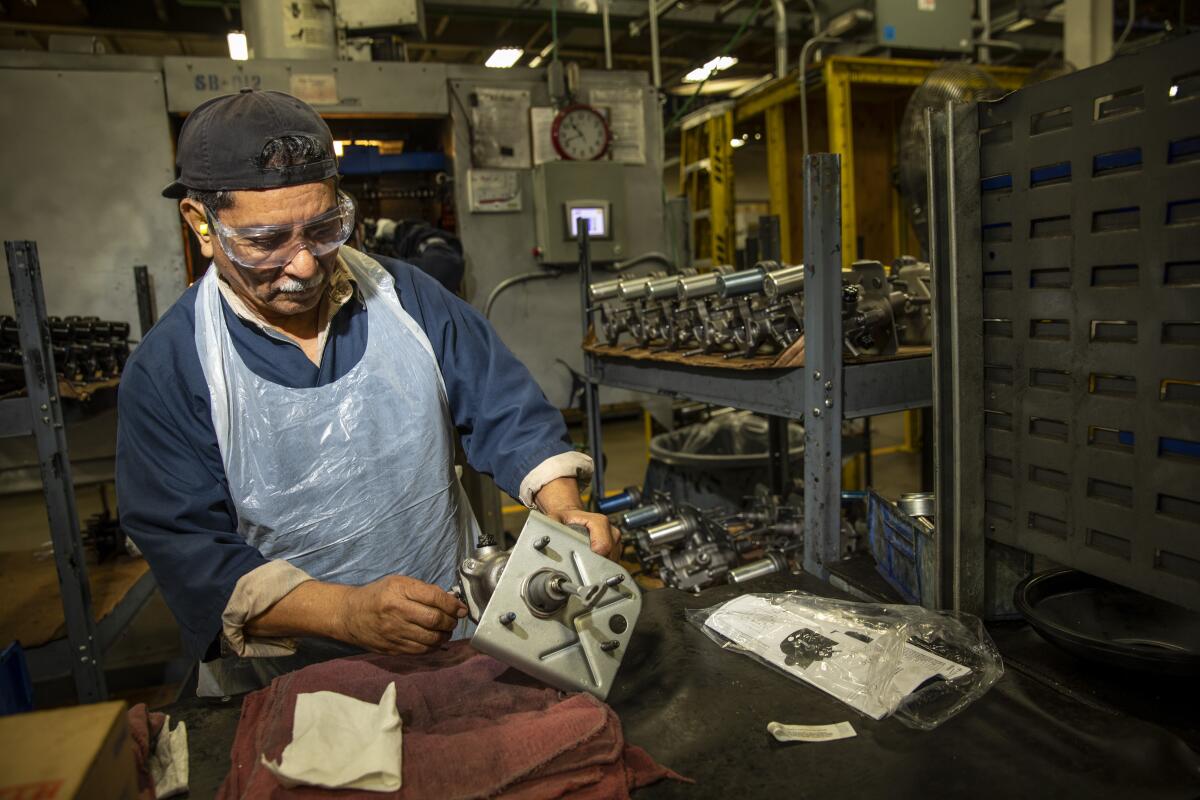In California, job growth is strong, but nationally, it’s a different story

- Share via
Job growth slowed nationwide last year, but it accelerated in California as the state notched a record 118-month employment expansion.
California’s unemployment rate held steady at its record low of 3.9% in December, the same as in November and down from 4.1% a year earlier. The nation’s unemployment rate also remained unchanged in December, holding at 3.5%.
The Golden State added 310,300 jobs in 2019, a 1.8% increase, to a total of 17.61 million, according to data released Friday by the California Employment Development Department. The previous year’s increase was 1.6%.
In contrast, job growth across the United States eased to 1.4% last year, from 1.8% in 2018.
California unions expand, as national labor organizing stagnates
“December marked the end of an impressive year for the state’s economy,” said Taner Osman, a researcher at Beacon Economics, a Los Angeles-based consultancy. “There was some pessimism surrounding the economy early last year. The stock market had seen a major correction and there was anxiety about trade. The fears surrounding trade, for now, seem overblown. ... As consumers feel secure in their jobs, they spend money, and this, in turn, fuels the economy.”
December’s tally of nonfarm job growth was comparatively modest, at 12,600, down from a revised gain of 24,000 in November, as the state has approached what economists consider full employment.
But with businesses scrambling to fill openings, more Californians were finding jobs or looking for work. After the labor force contracted for six consecutive months beginning in March, nearly 165,000 people entered or reentered the job market over the last four months. As a result, the labor force rose 0.2% over the year.
At the same time, the nation’s labor force grew by 0.9%.
The number of unemployed Californians — 757,700 in December — “is the lowest since 1989, despite large gains in statewide population since,” the EDD report noted.
“California’s strength in technology and its economic diversity helped it to overcome the negative forces hurting the Midwest and other parts of the country more dependent on manufacturing,” said Lynn Reaser, an economist at Point Loma Nazarene University in San Diego.
Year over year, the largest California job gain was in professional and business services, which added 71,500 positions, including 6,600 in December. The sector — which includes scientific and technical services such as software engineers, system analysts and scientific research and development — “remains the workhorse of the state’s economy,” said Loyola Marymount University economist Sung Won Sohn.
Other growth sectors in 2019 included:
- Education and health services (up 98,100)
- Government (40,300)
- Construction (31,300)
- Leisure and hospitality (28,000)
- Financial activities (13,000)
- Information (11,600)
- Manufacturing (11,400)
- Agriculture (7,800)
- Trade, transportation and utilities (2,100)
No sectors lost jobs over the year, although mining and logging, which includes petroleum extraction, added just 100 jobs.
Despite the state’s low unemployment rate, Michael Bernick, a workforce expert and former EDD director, noted that many out-of-work Californians are not counted in the 3.9% tally because they are not actively looking for jobs. Including those who are classified as “discouraged, marginally attached to the workforce and involuntarily working part-time” raises the jobless rate above 7%, he said.
“Many of California’s unemployed today do not easily fit into current and projected job openings,” Bernick said, citing “mental health and behavior issues, lack of experience and mismatch of skills.”
Moreover, he said, “California employers can pull from a national and international labor pool. They have gotten choosy. They hold out for candidates who have experience in the specific job advertised. They’re reluctant to engage in training.”
County-level job data varied considerably in 2019, according to the EDD.
In Los Angeles County, nonfarm jobs grew by 67,800 to a total of 4.65 million. That was a 1.5% rise, led by healthcare and social assistance (up 28,000) and construction (up 8,500). The unemployment rate was 4.4% in December, down from 4.7% a year earlier.
In Orange County, nonfarm jobs grew by 25,400 to a total of 1.67 million. That was a 1.5% rise, led by professional and business services (up 8,400) and leisure and hospitality (up 7,700). Unemployment was 2.4% in December, down from 2.7% a year earlier.
In the Inland Empire, spanning Riverside and San Bernardino counties, nonfarm jobs rose by 30,900 to a total of 1.57 million. That was a 2% rise, led by healthcare and social assistance (up 13,300) and professional and business services (up 6,900). Unemployment was 3.5% in December, down from 3.9% a year earlier.
More to Read
Inside the business of entertainment
The Wide Shot brings you news, analysis and insights on everything from streaming wars to production — and what it all means for the future.
You may occasionally receive promotional content from the Los Angeles Times.












